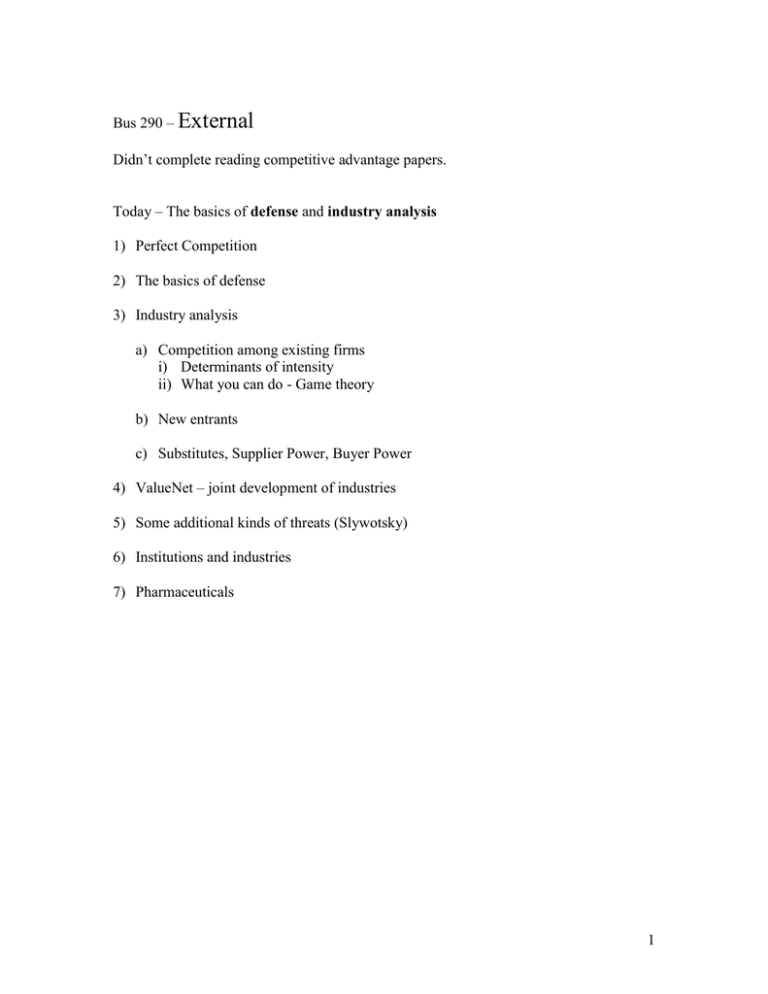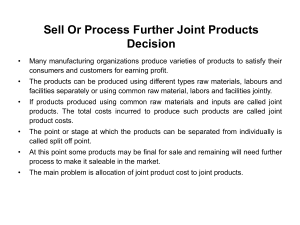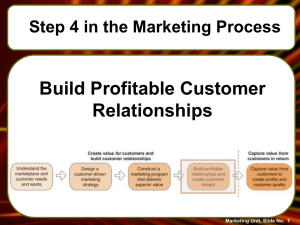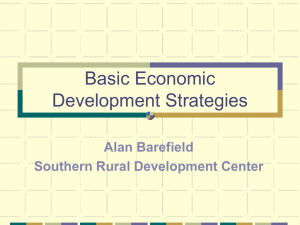External
advertisement

Bus 290 – External Didn’t complete reading competitive advantage papers. Today – The basics of defense and industry analysis 1) Perfect Competition 2) The basics of defense 3) Industry analysis a) Competition among existing firms i) Determinants of intensity ii) What you can do - Game theory b) New entrants c) Substitutes, Supplier Power, Buyer Power 4) ValueNet – joint development of industries 5) Some additional kinds of threats (Slywotsky) 6) Institutions and industries 7) Pharmaceuticals 1 I. Points to extend what we said last time a. Starbucks – Howard Shultz – I think I disagree with most of you leadership/great individuals are important, and get systematically neglected by strategy scholarship. i. When I did my post-doctoral fellowship at Harvard, my office was in Morgan Hall. Who was that named after? ii. No one every said a word about Morgan 1. Next door neighbor asked, ‘was there a businessman named Morgan?’ b. Someone sent me an email – Starbucks got beaten up in the markets. Don’t assume that says anything at all about Starbucks’ strategic management. i. P/E = 54.9 II. Perfect Competition a. Many sellers, many buyers, no one controls the price. - potatoes b. We don’t want it. c. Can we ever make money under perfect competition? i. Gold d. So there are situations where working under perfect competition is ok, and that means working with none of what Walker calls defense. i. But they only happen when we have a lot of something that’s fantastically valuable to others. 1. Producers of certain kinds of edible Japanese mushrooms 2. Certain kinds of medical doctors ii. And even then, it may be worthwhile to look for defense. 2 III. :16 The Basics of defense – What Walker calls defense is about preventing your business from having an experience like perfect competition. “isolating mechanisms” a. Isolating mech = ways you can separate yourself from the kind of competition that the potato producers face. i. Basically two kinds b. Preventing imitation of resources and capabilities i. - most drivers can be copied. – potato producers. ii. Property rights – patents, etc. 1. People tend to overestimate this. a. Xerox when started in the 1950s the technology was so unusual and their lawyers were so good that they set up patents nobody could go around. b. But most patents can be beaten. Biotechnology innovations – if you understand how one molecule works, you’ll probably be able to create another molecule that will do the same thing. iii. Dedicated assets – You own something someone else can’t get hold of. 1. Entertainment – very profitable – they control the channels. 2. Store shelves - big supermarkets, lots more kinds of Kellogg’s cereals, Coca-Cola drinks. iv. Causal ambiguity – you can copy only imperfectly. This may be the biggest opportunity for most organizations. 1. SouthWest Airlines turnaround system – 20 minutes. 2. Sony got better pictures than others. a. Quality control, not high tech b. Took 15 years for others to copy it. 3. It’s really dangerous to disclose things that seem obvious. v. Learning costs – it takes time and money to copy, and maybe by the time you have copied the leader will have developed something new. 1. It often costs more to do it faster. 3 Mechanisms of preventing (or limiting) imitation are very important. Enormous contribution to whether a business will really make money. How can/do the companies you studied prevent imitation? c. Increasing customer retention - seek switching costs i. Search costs 1. IBM, now Microsoft - “Fear, uncertainty, and doubt” 2. “Experience goods” – you don’t know whether the product is good till you invest real money in it. IT consulting. - the opposite of a commodity – a spectrum. ii. Transition costs – time and money it takes to get rid of PeopleSoft applications at San Jose State and replace them with SAP iii. Learning costs. iv. How to increase switching costs 1. customization, knowledge of customer is better. 2. Excellent service helps – service is an experience good 3. Build reputation - Xynteo vs. MIT Which of the companies you studied can discourage switching? 4 IV. :38 Industry analysis. – a. What is an industry? P. 56 firms whose products do the same thing in (more-or-less) the same way, and whose products compete with each other through changes in price and value. i. Last year – Unilever and Colgate – doing badly. Why? P&G has innovations in baby diapers and toothpaste. (household products) ii. Industry sector – consumer products with non-prescription medicines, packaged foods iii. Industry segment – within an industry. 1. low-cost baby diapers 2. premium baby diapers 3. within autos – a. sports cars b. minivans c. family sedans (a segment can easily be made obsolete.) iv. Strategic groups – groups of firms with an industry that mostly compete with each other 1. pharmaceuticals a. makers of high-cost drugs b. generics 2. beer a. standard brands (Bud, Miller) b. craft brews 3. autos a. full-line car makers i. GM ii. Ford iii. Toyota iv. Nissan b. Luxury makers i. BMW ii. Mercedes iii. Jaguar c. Sports cars i. Porsche ii. Alpha Romeo 5 4. recently there is a trend to merge across strategic groups. It isn’t clear that it’s working b. Suppose you invent something completely new – will you be part of an industry? copying i. We’ll talk about industry evolution next time, but for now it’s a good idea just to think about industries that are fairly well established. 1. Initially – products are really different. a. pictures of early cars. b. early PCs. c. early airplanes. ii. When things are established, customers and producers and employees tend to know what to expect. 1. It’s hard to innovate radically. 6 c. The best way to think about an industry is probably to organize the threats to profitability through Porter’s 5 forces, then once we’ve thought about them think about profitable development of the industry through Brandenberger & Nalebuff’s Value Net concept. i. Competition among existing firms – Monopoly is rare, and if you have one, it’s a crime to try to perpetuate it. But perfect competition is rare too, ;so usually we have oligopolistic competition. 1. simplest - barber shops a. In an industry with some form of oligopoly, what would result in above average returns? 2. toothpaste – pretty profitable. Why? a. Consolidated industry. Concentrated. There is a moderate tendency for concentrated industries to be more profitable. 3. airplane manufacture. a. Consolidated, but intense rivalry. b. Profitability is cyclical. c. Often not profitable. Why? 4. What influences the level of rivalry among firms? a. Demand conditions i. growth helps ii. economies of scale hurt – if everybody has to build more capacity than they need, there’s a tendency for them to be always undercutting each other. b. Exit barriers. Steel, autos c. Can you get “tacit collusion?” 7 5. Instead of going through the huge economic analysis of collusion that Walker gives, I want to start out with a very simple game theory example, then look at a more complex example, then give you the best hint I’ve seen in the literature. a. Game theory – firms act as if they were playing a game with each other taking each others’ likely responses into account, like chess or poker. b. UPS vs. FedX i. Look forward and reason back c. Prisoner’s dilemma Prisoner A Silent Confess Prisoner B Silent 6 mo, 6 mo A free, B 20 yrs Confess A 20 yrs, B free A 10 yrs, B 10 yrs Similarly, Reata vs. Ponderosa ranch. d. Anti-trust laws limit coordination. So what do you do? i. Try signaling. ii. When they misbehave – tit for tat. 8 :72 ii. New entrants / entry barriers 1. Things existing firms can do a. Property rights b. Absorbing key resource c. Causal ambiguity d. Learn things that are expensive for others to learn. e. Create emotional brand loyalty. 2. External forces a. Govt regs. iii. Substitutes Things people buy from outside your industry. soft drink makers vs. Brita filters For Meredith & Rob, a course at San Jose State is a substitute. iv. Buyer power car companies and their suppliers v. Supplier power PC makers and Microsoft d. Example – Ken’s boat business. V. Complete the competitive advantage model on board (p. 49) 9 VI. 10:22 BUT – Not all interactions between companies in an industry are attacks. Working together – not as well worked out as rivalry, but just as important. a. ValueNet – draw chart from p. 79. b. Sharing info – P&G works with Wal-Mart c. Sharing resources & capabilities – Toyota building its supplier base. i. Benefit of having part of this be proprietary. GM having trouble learning from Toyota. d. Recently – competitors develop standards for broadband. e. Today – developing the entertainment systems of the future. f. the evolution of the industry allows lots of players to make money. g. The writers who talk about this don’t seem to be the ones who do it best. h. Has anyone ever been involved in this? i. AT&T & its consultants ii. IBM & Microsoft on e-commerce. 10:45 BREAK 10 11:05 VII. Other sources of threats – Slywotsky a. What did you think? b. So far we’ve presented the academic model, but the academic model doesn’t give us the whole story. What is “the biggest risk of all?” a radical shift in the market. c. What is ‘enterprise risk management’ ? d. What do you think of the solution on p. 49? e. Is the overall idea valid? i. Yes, so let’s look at the specifics. f. Try to think constantly of the biggest risks and the opportunities they may hide. i. Bill Russell quote – p. 55. ‘rebounding is the start of offense.’ 11 11:35 VIII. One more point about industries – they have and are institutions. a. Nature of institutions i. Rules of the game (regulative – economics) ii. Taken for granted part of our thinking (cognitive – sociology) iii. Seen as appropriate (political science) b. You see this in every industry. c. You also see within organizations d. You also see between countries (this is most famous) e. People want to change through government, but passing laws doesn’t completely change things. 12 IX. 11:45 Pharmaceutical industry – I want to say from the outset that where I had a sense with Wizards of the Coast and Starbucks that each can give us some pretty clear, simple illustrations and lessons, I don’t think things are clear and simple in the pharmaceutical industry. But I think it can i. illustrate key uses of our approach to industry analysis ii. illustrate why we have to go beyond it. b. Earlier I mentioned 2 strategic groups in the pharmaceutical industry. The case adds a third biotechnology what’s the difference? c. Based on the info in the case and the framework we have from Porter, do you think big pharma is profitable? one of the most profitable industries AstraZ – 31.4% Glaxo – 50.6% i. do you think biotech will be profitable over time? ii. Do you think generic pharmaceuricals will be profitable? d. Do you think is the future of this industry will be good or bad? i. Here we have numbers – Exh 1. 13 e. That’s about as much as we can say with confidence, but it’s quite a lot. f. What kind of strategies do you think you would want to adopt i. in generic pharmaceuticals. ii. in biotechnology. iii. in big pharma. Can anybody estimate what share of the business is big pharma today? Total business in 2003 - $466 bil. 20 largest biotech are approx $20 bil g. Is there a right way to regulate this industry? h. What we’re finding here (complexity and confusion) is perhaps a bit extreme. But it’s indicative i. for firms, strategies should and often can be clean and simple ii. industries, especially industries where big profits are available, are usually messy iii. theory can give us some basic parameters, then we have to struggle. 1. What I’m looking for really is the simple strategy that will deal effectively with complex reality. 14



